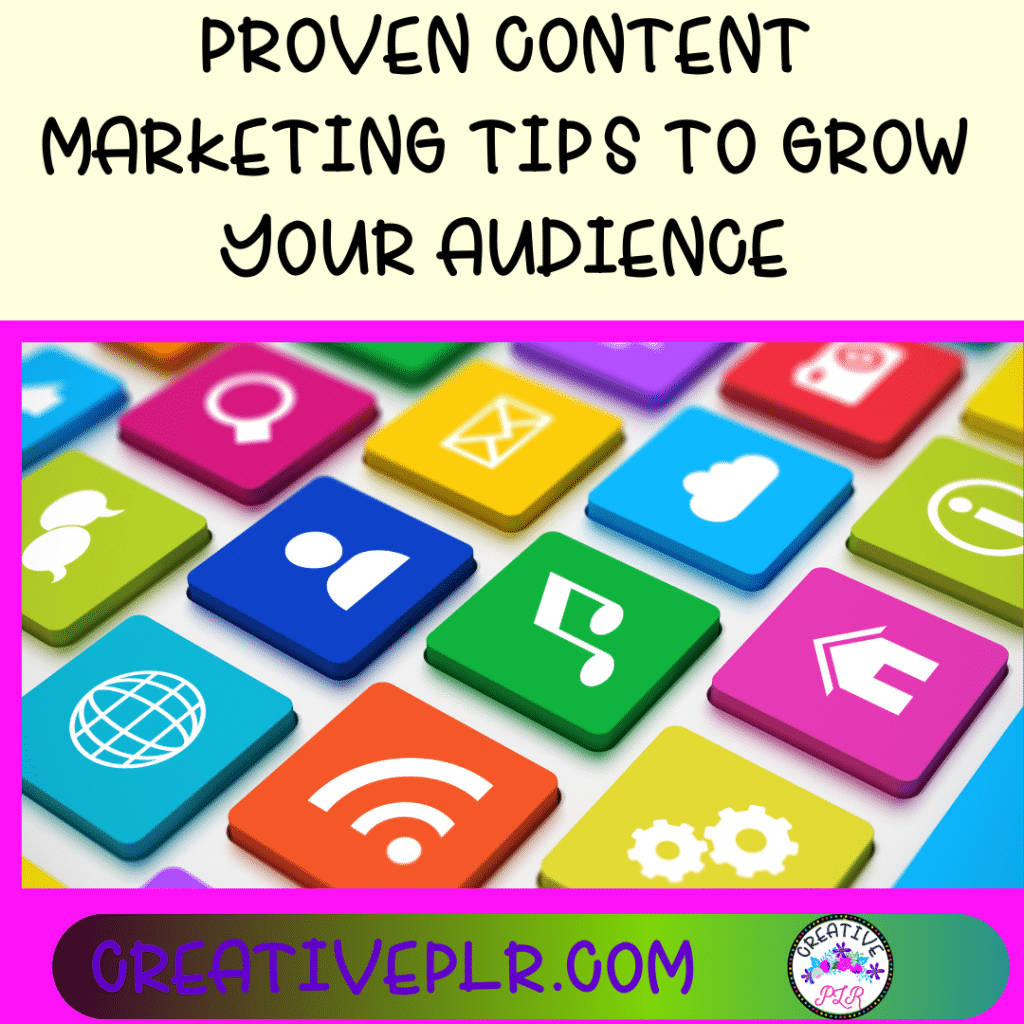Have you ever wondered how some brands seem to magically attract large audiences? The secret often lies in using some effective content marketing tips. Today, in the digital age, knowing how to make and share good content can greatly boost engagement. It can also build brand loyalty and generate leads.

Today we are going to look at practical content marketing tips to help you grow your audience in 2024. Let’s dive into strategies that work. They include: understanding your audience. Making compelling content. And using many channels to share your message. Ready to turn your content into a powerful tool for growth?
Understanding Your Audience
First, you need to know your audience. Then, you can create content that captivates and converts. Your audience is the core of your content marketing strategy. Knowing them well makes it easier to tailor your message to meet their needs. This includes their interests and pain points. Let’s explore how understanding your audience can make your content marketing more effective.
Conducting Audience Research
Knowing your audience isn’t a one-time task. It requires continuous research and updating. Here are a few techniques to help you get started:
- Surveys: Send out surveys to your existing customers. Ask questions about their habits, preferences, and challenges. This is a free and direct way to get valuable information.
- Social Media Analytics: Platforms like Facebook, Twitter, and Instagram offer insights into who is engaging with your content. Use these tools to find data on your audience’s age, location, and interests.
- Competitor Analysis: Look at your competitors and analyze their audience. What kind of content do they produce? Who engages with it? Use tools like BuzzSumo or SEMrush to gather this information.
By understanding your audience, you can create more targeted and effective content that resonates and engages.
Crafting High-Quality Content
Creating high-quality content is a vital part of any successful content marketing strategy. It helps engage your audience. It builds trust and shows your brand as an authority in your niche. Good content isn’t just about writing well. It’s also about offering value and optimizing for both readers and search engines. Let’s explore how you can elevate your content game.
Types of Content to Engage Your Audience
Different types of content appeal to different segments of your audience. Mixing up the types of content you produce can keep your audience engaged and coming back for more.
- Blog Posts: These are great for in-depth discussions on topics relevant to your audience. Blog posts can range from how-to guides to opinion pieces. Their versatility makes them a cornerstone of content marketing.
- Videos: Video content is highly engaging and can capture attention quickly. Whether it’s a tutorial, a product review, or a behind-the-scenes look at your business, videos can convey your message more dynamically than text alone.
- Infographics: Infographics are visual representations of information or data. They simplify complex information and make it more digestible. People love sharing infographics, which can drive more traffic to your site.
- Podcasts: Podcasts are an excellent way to reach audiences who prefer listening over reading. They allow you to delve deep into topics and feature interviews with experts, offering valuable content on-the-go.
Each of these content types has its own unique benefits and can cater to different audience preferences. By diversifying your content, you can keep your audience engaged and broaden your reach.
Optimizing Content for SEO
Creating high-quality content is just the beginning. To ensure that your content reaches a wider audience, you need to optimize it for search engines. Here are some actionable tips to help you rank higher on search engines:
- Keyword Research: Start by identifying relevant keywords that your target audience is searching for. Tools like SEMrush and Google Keyword Planner can be invaluable for this.
- On-Page SEO: This involves optimizing individual pages to rank higher. Here are some key elements:
- Title Tags: Make sure your titles are compelling and include your main keyword.
- Meta Descriptions: Write concise meta descriptions that include your target keyword and a call to action.
- Headings: Use headings (H1, H2, H3) to structure your content and include keywords where relevant.
- Quality Content: Ensure your content is original, valuable, and free of errors. Use simple language and break up text with headings and bullet points to improve readability.
- Internal and External Links: Use internal links to connect related content on your site. Include external links to authoritative sources, like this comprehensive guide on Crafting High-Quality SEO Content, to add credibility to your content.
- Mobile Optimization: Make sure your content is mobile-friendly. With more people accessing content on their smartphones, it’s crucial to ensure a seamless mobile experience.
Follow these SEO tips. They can boost your search engine rankings and bring more organic traffic to your site. This will help you grow your audience.
Remember, crafting high-quality content is both an art and a science. It’s about delivering value. You optimize for search engines to reach as many people as possible. Keep trying different types. Keep refining your approach. See what your audience likes best.
Promoting Your Content
You’ve crafted the perfect piece of content, but your job isn’t done yet. Promotion is crucial to ensure that your content reaches a wider audience. Effective promotion strategies can amplify your reach, drive engagement, and ultimately grow your audience. Let’s look at some of the best tactics for promoting your content.
Leveraging Social Media Platforms
Social media platforms are powerful tools for content promotion. To maximize your reach, you need to tailor your approach for each platform. Here are some best practices for promoting content on popular social media platforms:
- Share on Your Page: Post your content on your business page and encourage your followers to share it.
- Join Groups: Participate in Facebook groups related to your niche and share your content where relevant.
- Use Facebook Ads: Boost your posts or run targeted ad campaigns to reach a broader audience.
- Tweet Regularly: Share your content multiple times with different headlines to capture attention.
- Use Hashtags: Utilize relevant hashtags to increase the visibility of your tweets.
- Engage with Followers: Retweet, like, and reply to comments to foster a community around your content.
- Leverage Stories: Use Instagram Stories to share snippets or behind-the-scenes content that links back to your main post.
- Utilize IGTV: Create longer-form video content that expands on your blog posts.
- Collaborate with Influencers: Partner with Instagram influencers to showcase your content to their followers.
- Post on Your Profile: Share your content directly on your profile and encourage your connections to engage.
- Join Relevant Groups: Participate in LinkedIn groups and share your content where it adds value.
- Publish Articles: Use LinkedIn’s publishing platform to write articles that complement your main content.
Measuring Success and Making Adjustments
When it comes to content marketing, the journey isn’t over once you hit “publish.” Measuring your content’s success. Making data-driven changes is crucial for growth. Tracking the right metrics. Using the right tools can help you see what works and what needs improvement. Let’s dive into the essentials.
Key Metrics to Track
Understanding the effectiveness of your content marketing campaigns starts with tracking key metrics. Here are some essential ones to consider:
- Engagement Rates: This includes likes, shares, comments, and time spent on your page. High engagement indicates that your content is resonating with your audience.
- Organic Traffic: Measure the number of visitors coming to your site through search engines. Organic traffic is a good indicator of how well your content ranks in search results.
- Conversion Rates: Track how often visitors take a desired action, such as signing up for a newsletter or making a purchase. High conversion rates mean your content is effective at driving actions.
- Social Shares: The number of times your content is shared on social media platforms. Social shares can amplify your reach and bring in new audience members.
Key Metrics Summary:
- Engagement Rates: Interactions such as likes, comments, and shares
- Organic Traffic: Visitors from search engines
- Conversion Rates: Actions taken (e.g., signing up, purchasing)
- Social Shares: Content shares on social media
Understanding these metrics can give you a clear picture of your content’s performance and help guide your future strategies.
For a deeper dive into measuring content marketing effectiveness, check out How to Measure Your Content Marketing Effectiveness.
Using Analytics Tools
To measure these metrics effectively, you need the right tools. Here are some analytics tools that can provide valuable insights:
- Google Analytics: A comprehensive tool to track website traffic, user behavior, and conversion rates. You can set up goals to measure particular actions users take on your site.
- SEMrush: This tool offers detailed insights into organic search traffic, keyword performance, and competitor analysis. It’s great for understanding your content’s SEO effectiveness.
- Social Media Insights: Platforms like Facebook, Instagram, and Twitter offer their own analytics to measure engagement, reach, and demographic information about your audience.
Recommended Analytics Tools:
- Google Analytics: Track website traffic and conversions
- SEMrush: Analyze SEO performance and competition
- Social Media Insights: Measure engagement and reach on social platforms
Using these tools can help you gather actionable data to fine-tune your content marketing strategy.
For more information on measuring your content marketing performance, take a look at How to Measure Content Marketing Performance.
Making Data-Driven Adjustments
Once you have collected and analyzed your data, the next step is to make informed adjustments to your content marketing strategy. Here’s how:
- Identify What’s Working: Focus on the content that receives high engagement and conversions. Consider producing similar topics or formats to replicate success.
- Optimize Underperforming Content: Look for content with low engagement or conversion rates. Re-optimize it by improving headlines, updating keywords, or enhancing visuals.
- Adapt to Trends: Stay updated with industry trends and audience preferences. Use analytics to spot emerging trends and adapt your content strategy accordingly.
You should measure your success. Then, make informed adjustments. This will keep your content marketing strategy fresh and effective. For further reading, check out The Ultimate Guide to Measuring Your Content Marketing.
Remember, measuring success and making adjustments isn’t a one-time task. It’s ongoing. It can lead to continual growth in your audience.
Growing your audience through content marketing requires a strategic approach and consistent effort. Understanding your audience is key. So is crafting good content, promoting it well, and measuring your results. These strategies, when combined, will help you create a well-rounded content marketing plan.
It also involves tweaking your approach, so don’t be afraid to try new things and experiment. Do you have a unique approach that is building your audience? I would love to hear. Drop me an email at [email protected] and let me know.


